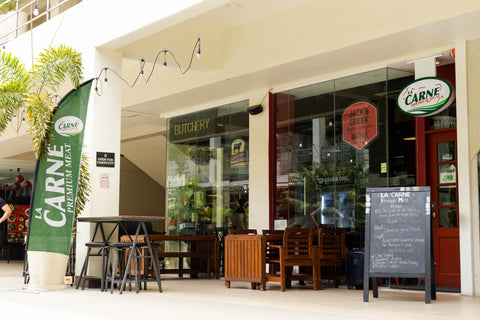Storing meat at home can be tricky, especially if you like buying in bulk. Many households in the Philippines prefer stocking up on beef, or lamb to save time and money. But if you’ve ever opened your freezer only to find dry, discoloured meat or strange odours, you’re not alone. The problem often lies in how the meat is frozen and defrosted. Improper storage can affect texture, taste, and even safety.
Freezing and defrosting meat the right way is one of the most important steps in food safety. Whether you’re storing meat for a few days or several weeks, following proper methods can keep it fresh, nutritious, and safe to eat. And if you get your meat from the best wholesale meat supplier in the Philippines, you can ensure the quality stays consistent for a longer duration.
Let’s look at how to freeze and defrost different types of meat safely.
Why Freezing Meat Properly Matters?
Freezing slows down the growth of bacteria and preserves the meat’s natural flavour. However, freezing the wrong way, such as using thin packaging or letting the meat sit at room temperature too long before freezing, can lead to freezer burn, loss of texture, and even spoilage.
When done right, frozen meat can last for months without losing its freshness. The key is to control air exposure, temperature, and timing.
How to Freeze Different Types of Meat
Not all meats freeze the same way. Some cuts can be stored for months, while others should be used sooner to maintain their taste and tenderness.
1. Beef
Beef freezes well because of its fat content. Before freezing, portion the meat according to how you plan to cook it. For example, divide ground beef into meal-sized portions, and wrap steaks or roasts individually.
Use airtight packaging like vacuum-sealed bags or double layers of cling film and foil. This prevents air from getting in and causing freezer burn. Label each package with the date so you can use the oldest first.
Freezing tip: Keep the temperature at -18°C or lower. Beef can stay frozen safely for up to 3 months, but for the best flavour, use it within a month or two.
2. Lamb
Lamb can also be frozen for long periods without losing much quality. For cuts like chops or shanks, wrap them tightly in freezer-safe paper or vacuum-sealed bags. If you’re freezing minced lamb, flatten it into thin portions to make thawing faster later.
Freezing tip: Always remove as much air as possible before sealing. Store lamb for up to 9 months.
3. Ground Meat and Minced Meat
Ground meats have more surface area exposed to air, which means they can spoil faster. Divide into small, flat portions before freezing. This not only saves space but also makes defrosting quicker and safer.
Freezing tip: Label with the type of meat and freezing date. Use within 3 to 4 months for the best flavour.
How to Defrost Meat Safely?
Defrosting is just as important as freezing. Many people make the mistake of leaving meat on the kitchen counter to thaw quickly, but that can lead to bacterial growth. Instead, use one of these safe methods:
1. In the Refrigerator (Safest Method)
This is the best and safest way to defrost meat. Move the meat from the freezer to the fridge 24 hours before you need it. The cold temperature keeps bacteria from multiplying while slowly thawing the meat.
-
Small cuts like steaks usually take 24 hours.
-
Larger cuts like roasts may take up to 2 days.
Tip: Place the meat in a bowl or on a tray to catch any liquid that might drip during defrosting.
2. In Cold Water (Faster Option)
If you need to defrost meat quickly, you can use the cold water method. Submerge the sealed meat in a bowl of cold water and change the water every 30 minutes to keep it cold.
-
Small cuts can thaw in about an hour.
-
Larger cuts may take 2 to 3 hours.
Important: Never use warm or hot water—it encourages bacteria growth. Cook the meat immediately after defrosting with this method.
3. In the Microwave (Quickest Method)
When you’re in a hurry, the microwave can defrost meat in minutes. Use the defrost setting and follow your microwave’s instructions carefully. However, note that the edges of the meat may start to cook slightly during this process, which can affect texture.
Once thawed, cook the meat immediately don’t refreeze it.
Common Mistakes to Avoid
Even with good intentions, it’s easy to make small mistakes when freezing and defrosting meat. Here are a few to watch out for:
-
Freezing meat in its supermarket packaging: Thin plastic wrap isn’t airtight and can lead to freezer burn. Repackage the meat using freezer-safe materials.
-
Refreezing thawed meat: Once thawed, meat should not be refrozen unless it’s been cooked first. Refreezing raw meat can cause bacterial contamination and affect flavour.
-
Leaving meat out too long: Never let raw meat sit at room temperature for more than 2 hours. In warm climates like the Philippines, even 1 hour can be risky.
-
Not labelling packages: Forgetting to date your frozen meat can lead to confusion later—and you might end up eating meat past its best quality.
Bonus Tips for Keeping Meat Fresh
-
Freeze meat as soon as you get home, especially if it’s a hot day.
-
Store meat on the lowest shelf in your freezer for consistent temperature.
-
Don’t overload the freezer—air needs to circulate for even freezing.
-
For long-term storage, consider vacuum sealing to preserve taste and nutrients.
Choosing the Right Supplier
Even the best freezing techniques can’t make up for poor-quality meat. Always start with fresh, premium cuts from a reliable source. A trusted bulk meat supplier in the Philippines can provide you with high-grade beef, lamb, and poultry that maintain their texture and taste even after freezing.
When you choose a supplier known for freshness and proper handling, you’re ensuring that every meal you prepare is safe and delicious. Whether you’re a restaurant owner, a home cook, or running a catering business, choosing quality from the start makes all the difference.
In a nutshell..
Freezing and defrosting meat the right way is a small step that makes a big difference in food safety and taste. Always remember to freeze meat quickly, wrap it tightly, and thaw it slowly. By following these simple tips, you can enjoy tender, flavourful meat every time without worrying about spoilage or contamination.
For those who prefer convenience and quality, sourcing from a bulk meat supplier in the Philippines ensures your meat is fresh, safe, and perfect for long-term storage.
Love,
Team La Carne



